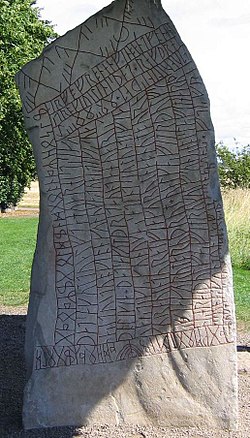Rökstone
| Rök Runestone | |
|---|---|
 |
|
| Rundata ID | Ög 136 |
| Country | Sweden |
| Region | Östergötland |
| City/Village | Rök |
| Produced | 800 |
| Runemaster | Varinn |
|
Text – Native |
|
| Old Norse: See article. | |
| Text – English | |
| See article. | |
| Other resources | |
|
Runestones – Runic alphabet Runology – Runestone styles |
|
Coordinates: 58°17′42″N 14°46′32″E / 58.29500°N 14.77556°E
The Røk Runestone (Swedish: Rökstenen; Ög 136) is one of the most famous runestones, featuring the longest known runic inscription in stone. It can now be seen beside the church in Rök (between Mjölby and Ödeshög, close to the E4 and Lake Vättern and Tåkern), Östergötland, Sweden. It is considered the first piece of written Swedish literature and thus it marks the beginning of the history of Swedish literature.
The stone was discovered built into the wall of the church in the 19th century and removed from the church wall a few decades later. The church was built in the 12th century, and it was common to use rune stones as building material for churches. The stone was probably carved in the early 9th century, judging from the main runic alphabet used ("short-twig" runes) and the form of the language. It is covered with runes on five sides, all except the base part that was to be put under ground. A few parts of the inscription are damaged, but most of it remains readable.
The name "Rök Stone" is something of a tautology: the stone is named after the village, "Rök", but the village is probably named after the stone, "Rauk" or "Rök" meaning "skittle-shaped stack/stone" in Old Norse.
...
Wikipedia
